Tuesday, 25 June, Tour of Trier and tasting at Bernkastel-Kues
Written 25 July 2019
After supper that first night, Ivan the on-board musician entertained all comers in the lounge with piano and vocal standards. I'm actually pretty fond of "easy listening" and even of Lawrence Welk, so I knew his repertory pretty well. We didn't stay for it, but for guests who didn't want to stay up for didn't want to miss the fun, an entire channel on the TVs in the staterooms was dedicated to the lounge-cam, trained on the piano, so you could watch and listen from the comfort of your own bed. No ending time was ever given for his is evening performance. When we asked when it ended, we were told, "When the last guest leaves."
It seemed to me that the breakfast on board was sparser than that on, say, the Viking Hemming, but when I compared my description of that from the 2015 travel diary (24 August entry) with the inventory we were offered, I found they were the same. I wonder what made the difference—were the chefs on the Hemming just better at presentation? Or were the fruits in season in August in Portugal (fresh figs, canary melon), just more to my taste than those available in June in Germany (apples, oranges, bananas)? Puzzling.
During breakfast, I spotted a swan, a duck, a couple of cormorants, and a bunch of barn swallows (Hirundo rustica) zooming around just above the water's surface.
According to the Viking Daily left on my bed by housekeeping the night before, the morning's tour of Trier would depart at 8:45 a.m., so I hit the dining room as it opened at 7 a.m. (continental breakfast was available in the lounge starting at 6 a.m.). David elected to sleep in a little longer and just to grab a muffin off the coffee station on the way to the bus.
We met at reception, armed with the Quietvox devices we found in our staterooms, and picked up our boarding cards and group assignments for the day. The boarding card, which they sometimes call a "guest passport," is a little credit-card-sized paper thing with your name, cruise dates, ship name, and stateroom number on one side and all the ship's contact info on the other. The idea is that you pick it up from reception each time you leave the ship and turn it back in immediately on reboarding. If you get lost, fall down and hurt yourself, or otherwise run into trouble ashore, you can call for help or have a local do it for you. Each card has its own little compartment in a set of drawers at reception, so before casting off each time, the staff can scan for missing cards to make sure everyone is back on board. The group assigment is a plastic card that tells you what bus to board or what guide to follow for the day's tour. When you reach the beginning point of the walking tour, your Viking tour escort turns you over to a local city guide and tells you the channel to tune your Quietvox unit to. The guide then talks in a normal conversational tone into the mike on the Quietvox master unit, and his or her words go straight to your ears, without the need for shouting or crowding close to hear.
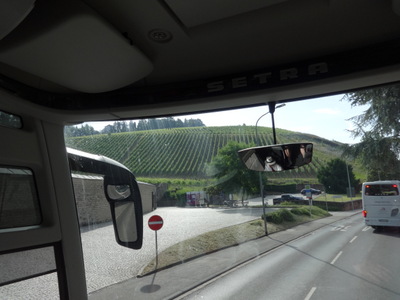
 The day's tour started with a bus ride up the hill to a high point overlooking the city and the river. Out the windshield of the bus, we got our first sight or Riesling vines. To our surprise, nobody here practices "contour plowing"; the rows of vines invariably run straight up and down the hills, on slopes that are sometimes as steep as 60°! We later learned that this is the orientation that maximizes exposure of the vine leaves to the sun.
The day's tour started with a bus ride up the hill to a high point overlooking the city and the river. Out the windshield of the bus, we got our first sight or Riesling vines. To our surprise, nobody here practices "contour plowing"; the rows of vines invariably run straight up and down the hills, on slopes that are sometimes as steep as 60°! We later learned that this is the orientation that maximizes exposure of the vine leaves to the sun.
Along the way, we first passed what was once a small fishing village, but is now all boutiques and restaurants. No professional fishermen remain in town. Along the river bank near it is an actual Roman-era crane, which was used for loading and unloading boats. It takes the form of a squat cylindrical tower with a conical roof. Two booms project from holes in the sides near the top, and the ropes and pulleys were powered by treadwheels inside. Apparently it remained usable until recently enough that it has been preserved intact.
At the top of the hill, we got a much closer look at the vines, which were just then bearing baby grapes about the size of bebe shot.
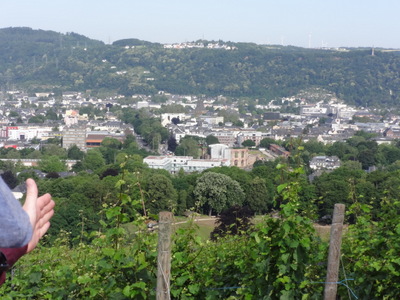
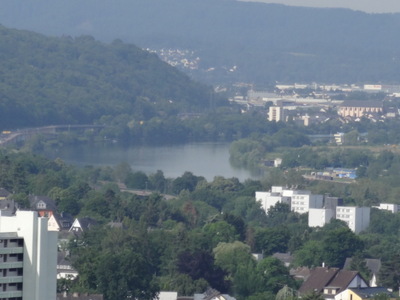 The view was panoramic. At the left here, the guide indicaes the middle of town. Front and center among the buildings, just beyond the band of trees is a large white structure, and sticking off the right-hand side of it is a pinkish structure with four tall openings in it. That pinkish structure is a Roman ruin. Near the top of the hill on the other side of the river (which itself is hidden by buildings and trees) near the right-hand edge of the picture is a vertical structure (very small in the photo and also pinkish), Mary's column. Also along the ridge top, difficult to see because they are white against pale blue, is a line of modern windmills.
The view was panoramic. At the left here, the guide indicaes the middle of town. Front and center among the buildings, just beyond the band of trees is a large white structure, and sticking off the right-hand side of it is a pinkish structure with four tall openings in it. That pinkish structure is a Roman ruin. Near the top of the hill on the other side of the river (which itself is hidden by buildings and trees) near the right-hand edge of the picture is a vertical structure (very small in the photo and also pinkish), Mary's column. Also along the ridge top, difficult to see because they are white against pale blue, is a line of modern windmills.
The photo at the right shows a different view (to the left of the first one), where the river takes and bend and therefore reappears from behind the trees.

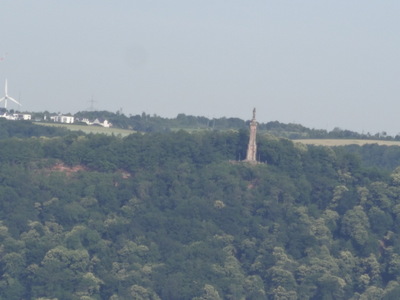 When I fired up the telephoto, I got much better shots of the Roman ruin and Mary's column.
When I fired up the telephoto, I got much better shots of the Roman ruin and Mary's column.
As you can see in this shot, the taller part of the white building is actually part of the Roman ruin (superstructure of the amphitheatre, I'm pretty sure) covered in white scaffolding for restoration. Less of the amphitheatre was above ground than usual, because the builders took advantage of a natural dip in the topography, so the amphitheatre was actually an earthwork rather than a stone structure. The guide said that the "shows" in the amphitheatre followed the usual plan we'd heard elsewhere. The day started with animal on animal fights (bull and bear, bear and dogs, etc.), then man-on-animal fights, then executions over lunch, then gladiators in the afternoon. The Roman theater, estimated to hold between 15,000 and 20,000 (depending on the average width of the Roman derriere) is still in use for renactments and a theater school. The Roman circus was behind the amphitheater. The Roman baths were the largest in the empire.
Trier was "the Delphi of the north," with the largest temple area north of the alps, including 70 temples of many different cultures.
To the left of the Mary's column, you can see a windmill peeking over the hill.

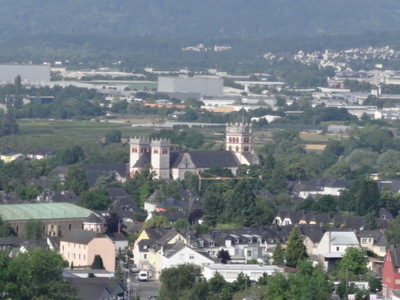 At the left here, also by telephoto, is St. Peter's cathedral. Just in front of it you can see part of the Liebfrauen Basilika, which we got to go inside later.
At the left here, also by telephoto, is St. Peter's cathedral. Just in front of it you can see part of the Liebfrauen Basilika, which we got to go inside later.
At the right is St. Martin's, a former benedictine abbey. St. Martin is the town's patron saint.
Underfoot as we enjoyed the view were pink clover, miniature white morning glories, a small intensely white umbellifer (yarrow?), purple vetch, sorrel, and a blue-flowered fuzzy thing that at the time I thought must be borage, but on checking further I think is more likely to be viper's bugloss (Echium vulgare).
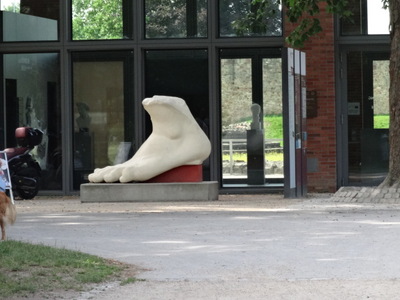
 Back down on the flat, our local guide continued with a walking tour of the city center. At the left here is a foot left over from Roman times, part of an oversize statue of Constantine the Great.
Back down on the flat, our local guide continued with a walking tour of the city center. At the left here is a foot left over from Roman times, part of an oversize statue of Constantine the Great.
At another point, we came down this ingeniously designed staircase, useable either as stairs or as a ramp.

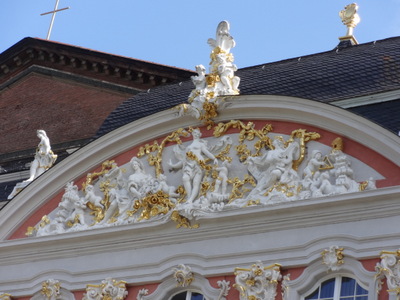 At the left here is the Prince Elector's palace. It used to have another long pink wing to the left of what you see here, and when it but was demolished, the most economical way anyone could come up with to restore the symmetry of the view (the other wing couldn't also be demolished because it contained a stairway that was considered a treasure even at the tim) was to plant the line of trees at the right, to hide the long pink wing that extends in that direction. At the right is a closer view of the decorations above the central doorway, which features quite a lot of unclothed women for an archbishop's palace. Flower beds surrounding the lawn are replanted twice a season. The first planting features tulips and other spring bulbs. We were there shortly after the second planting, and I saw dahlias, impatiens, begonias, marigolds, argeratum, nasturiums, dusty miller, and a dozen other things I couldn't name. There were lilacs in the nearby park, but they weren't in bloom. Gardeners on their hands and knees were using skinny, two-tined weeding rakes weed between the bedding plants.
At the left here is the Prince Elector's palace. It used to have another long pink wing to the left of what you see here, and when it but was demolished, the most economical way anyone could come up with to restore the symmetry of the view (the other wing couldn't also be demolished because it contained a stairway that was considered a treasure even at the tim) was to plant the line of trees at the right, to hide the long pink wing that extends in that direction. At the right is a closer view of the decorations above the central doorway, which features quite a lot of unclothed women for an archbishop's palace. Flower beds surrounding the lawn are replanted twice a season. The first planting features tulips and other spring bulbs. We were there shortly after the second planting, and I saw dahlias, impatiens, begonias, marigolds, argeratum, nasturiums, dusty miller, and a dozen other things I couldn't name. There were lilacs in the nearby park, but they weren't in bloom. Gardeners on their hands and knees were using skinny, two-tined weeding rakes weed between the bedding plants.
During the time of the Holy Roman Empire, the king was chosen by five "prince electors," two of whom were ordinary royal-blood type princes and three of whom were "princes of the church," i.e. archbishops; one of them was the archbishop of Trier, whose palace this was. All those naked women were supposedly symbols of the church's and the archbishop's love of their people. Once elected, the king could then journey to Rome to be made emperor by the pope.
The last prince elector was Louis XVI's uncle, and he made himself scarce after the French revolution.
In fact, for a very long period during Roman times, Trier was the capital of half of the empire and the seat of the emperor. The hugh red brick building that looms over the palace in both photos is Constantine's Basilica, the emperor's throne room. Citizens could actually come and present their problems and disputes before the emperor there, but the rules were that you didn't talk to the emperor and he didn't talk to you. You entered facing the emperor and knelt to him three times on your way. Your spokesperson presented your case, and then the emperor's spokesperson spent a good long time expounding on all that the great and beneficent emperor did for his people, and then it was somebody else's turn. You then withdrew backward (you couldn't turn your back on the emperor), again kneeling three times on the way. Apparently, you never knew what might or might not happen about your case.
Written 4 August 2019
It was on the occasion of some reconstruction and restoration of the basilica that the left wing of the palace was removed. The basilica was only the largest room the the huge palace from which the Constantinian family ruled the whole western part of the Roman empire. It's oldest wall was 9 feet thick. The huge hall was actually heated, with a hypocaust.
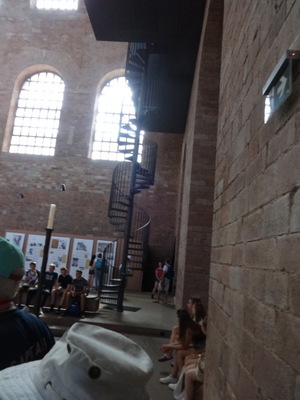
 The basilica is now a protestant church. Only about 10% of the city's population is protestant, and most of them work at the university. Because they're from all over, and were brought up in different protestant denominations, the church is of the Prussia United denomination, which is apparently the one most acceptable to everyone.
The basilica is now a protestant church. Only about 10% of the city's population is protestant, and most of them work at the university. Because they're from all over, and were brought up in different protestant denominations, the church is of the Prussia United denomination, which is apparently the one most acceptable to everyone.
Here are some views inside the basilica. The tall spiral staircase leads to the organ, part of which is shown at the right. The guide emphasized that the organ is very large. He didn't say how many pipes it had but made clear that the important part is that it has 400 more pipes than the one in the Catholic cathedral.
I'm pretty sure the guide was talking about the basilica when he said that at one time (before the current restoration), the building was bombed, and because enough light then entered through the holes in the roof, the windows were filled in and the room used for storage, then as a cattle shed. It has a Medieval wine cellar underneath.
Its walls were originally colorful marble, and the floors black and white marble. Statues occupied the niches, and the apse was decorated with gold mosaic. The ceiling was painted stucco. Today it includes Roman walls, Prussian walls, a German ceiling and roof, and the Roman emperor's throne. It's the largest hall ever built in the Roman empire.
Trier was a roman trade center until about 100 AD (the oldest graves in the Roman cemetery are from about 300 BC). Toward the end of the Roman period, in about 50 years, there were 70 emperors and usurpers. Average life expentancy of an emperor was 9 months. The longest lasted 9 years; the shortest killed himself after three weeks. In the 4th century AD, when Diocletian was forced to rule jointly with three others, one of them them lived in Trier.
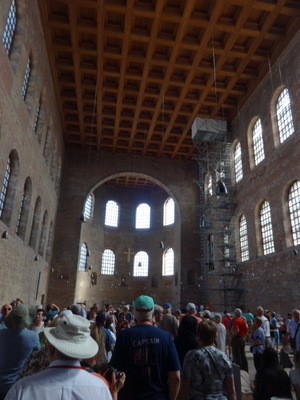
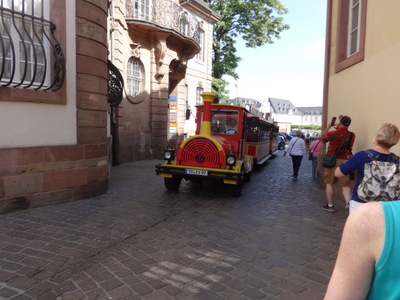 Here, at the left, is a more general view of the interior of the basilica (together with the back of David's head). The scaffolding supports a platform for people working on the ceiling.
Here, at the left, is a more general view of the interior of the basilica (together with the back of David's head). The scaffolding supports a platform for people working on the ceiling.
As you can see from the photo at the right, Germany also has little white tourist trains, but they aren't white. All the ones we saw in Germany were red and yellow.
Now, if you find that my accoount of Trier's role in the Roman Empire and the Holy Roman Empire and later periods is a little incoherent, that's because it is. I have never understood the relationship between the first, the second, and their transition into the third. Can some of you more historically educated readers straighten me out? Was it as simple as the Roman Empire became the Holy Romany Empire when Constantine converted to Christianity? Somehow I doubt it. Anyway, here's an initial summary of what I think happened in this region (and in fact in most of the area we covered on this cruise):
Recorded history started with the arrival of the Romans (from the west and south). Trier was founded by the Romans ca. 30 BC and is the oldest city in Germany (it's population is 110,000, and you have to have 100,000 to be a "city").
The Roman Empire persisted there for ca. 500 years and somehow transitioned into the Holy Roman Empire, and its focus shifted north, away from Rome and (at least for a period) to Trier.
The Franconians took over near the end of the 5th century, and the area we ruled by the Merovingien and Carolingiens dynasties. In 843, on the death of Charlemagne, his grandsons divided the area up among them, leading to the initial division into sections later thought of as French and German. At the division, Trier became part of Lorraine; in 870 it became part of East Frankish Empire, later called Germany under Henry I.
In 902, the archibishops took over control. Some cities managed to break away from them to become "free cities," answering only to the emperor, but Trier never managed to do so.
In 17th and 18th centuries the French (notably Louis XIV) passed through many times but didn't stay long. Every time they left, they took care to wreck everything on the way through. (Remember my account, in the 2009 diary, I think, of how Vauban finally talked Louis out of this fruitless and expensive practice?)
In 1801, the French came to Trier to to stay, but in 1814 the Prussians took it away from them. In 1870, France lost the Franco-Prussian war, so Lorraine, Alsace, etc. were annexed Germany.
After WWI, Alsace and Lorraine went back to France, but Trier didn't.
During WWII, Germany occupied those areas but didn't formally annex them and had to give them back when it lost the war. I actually know a lady who grew up in Metz, a French city occupied by the Germans. She and her little brother would go up to the attic of their house with slingshots and rocks and try (sometimes successfully) to knock pieces off the tall radio antenna on the roof of the adjacent German headquarters. Fortunately, they never got caught. Our guide pointed out that a local born near the end of the 19th century would have had to change his nationality four times in his lifetime, without leaving the house of his birth.
So is all that right? Let me know, you historians out there.
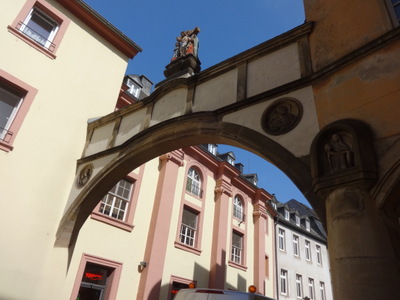
 Our walking tour continued to the cathedral, St. Peter's. Here at the left is the gate to the cathedral precinct (what the Brits would call the "close"). During the time when the archbishops ruled the area, the cathedral precinct was an entirely different district of law. It made a big difference whether you committee a crime inside or outside it, and if you reached it and got inside before they caught you outside, you were safe. Arresting you would have been a sin, which was worse than a crime. The gate was called the "turning around point," because it was where it was safe for a running miscreant to stop and look behind him.
Our walking tour continued to the cathedral, St. Peter's. Here at the left is the gate to the cathedral precinct (what the Brits would call the "close"). During the time when the archbishops ruled the area, the cathedral precinct was an entirely different district of law. It made a big difference whether you committee a crime inside or outside it, and if you reached it and got inside before they caught you outside, you were safe. Arresting you would have been a sin, which was worse than a crime. The gate was called the "turning around point," because it was where it was safe for a running miscreant to stop and look behind him.
Written 5 August 2019
At the right is a floor plan, showing the cathedral (or at least part of it), its adjoining cloister, and (in pink), the part we actually went inside, the Liebfrauen Basilika (Our Lady's Church). It was built by a French architect and French workers in light-yellow limestone. The "nave" is round, as you can see from the floor plan. The stained glass of the main church is in Shrewsbury, in England (it was sold to them in the 1850's), and has been replaced with plain glass. The windows in the Liebfrauen Basilika are modern, some of it by Chagall (who, we learned on this trip, designed stained glass for many, many churches across France and Germany).

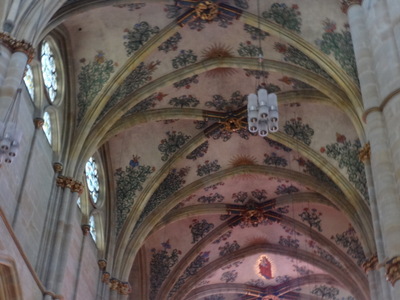 The inside of the basilica is sumptuously decorated. The guide showed us the exact spot (marked by a gold star set in the floor) on which to stand to have a full view of all the paintings on the 12 interior columns (the twelve apostles, I think). At the left here is a view into the apse of the church, and at the right a better view of its painted ceiling.
The inside of the basilica is sumptuously decorated. The guide showed us the exact spot (marked by a gold star set in the floor) on which to stand to have a full view of all the paintings on the 12 interior columns (the twelve apostles, I think). At the left here is a view into the apse of the church, and at the right a better view of its painted ceiling.
You can see the exterior of the apse in front of St. Peter's in the telephoto shot of it from the hill, above.

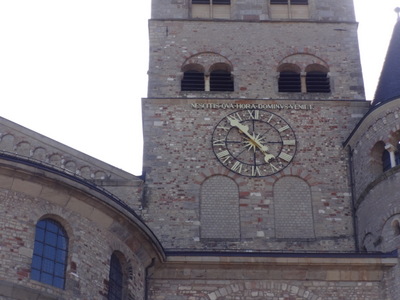 Here are a couple exterior shots of St. Peter's. In Roman times, it was the only church in the world larger than St. Peter's in Rome. It had four basilicas. Its baptismal font was about 20 feet square and knee deep (and is now marked by a stone outline in the pavement outside). Wading in up to your knees and pouring a spoonful of the water over your head counted as a "full-immersion" baptism.
Here are a couple exterior shots of St. Peter's. In Roman times, it was the only church in the world larger than St. Peter's in Rome. It had four basilicas. Its baptismal font was about 20 feet square and knee deep (and is now marked by a stone outline in the pavement outside). Wading in up to your knees and pouring a spoonful of the water over your head counted as a "full-immersion" baptism.
In 882 AD, Vikings arrived on Good Friday and left on Easter Monday, and in those four days they sacked the town and burned the cathedral. It took 200 years to rebuild. The present facade therefore dates from the middle ages. It's Roman in appearance but Romanesque in style. The semicircular bulge on the front, between the towers, was modeled on the local Roman hot baths, which at the time people thought were a temple.
A roman column, found during excavations, lies on its side outside one of the doors.
The guide didn't translate the Latin inscription on the clock face, but it looks to me as though it says "You don't know when God will come."
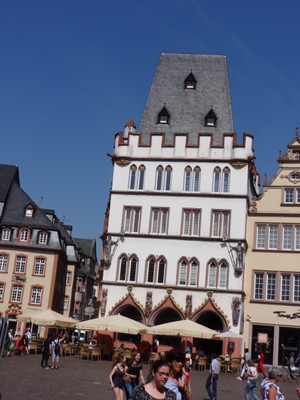
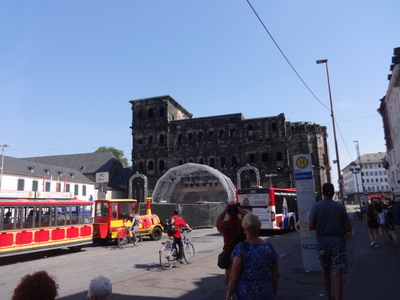 At the left here is the market square. In its center (not visible in this shot) is the market cross, the oldest (and the only) Celtic market cross in Germany; it stands on a Roman column. Out of the shot to the left is the oldest pharmacy in Germany (mentioned in 13th-century; at one time, that whole side of the square was pharmacies). As the guide pointed out, because Trier is the oldest city in Germany, everything there is the oldest of its kind. We also walked along the oldest "New Street" in Germany.
At the left here is the market square. In its center (not visible in this shot) is the market cross, the oldest (and the only) Celtic market cross in Germany; it stands on a Roman column. Out of the shot to the left is the oldest pharmacy in Germany (mentioned in 13th-century; at one time, that whole side of the square was pharmacies). As the guide pointed out, because Trier is the oldest city in Germany, everything there is the oldest of its kind. We also walked along the oldest "New Street" in Germany.
The building in the middle of the shot, with the three peaked red arches, is the city's drinking and festival hall. They would party in there for four days at a time, consuming 9 litres of wine per person per day.
Hard to make out in this photo are two armored knights mounted on the corners of the second floor. The one on the left is unarmed and has his visor up. Theone on the right—the only one visible from the archbishop's palace— carries a sword and has his visor closed. The townspeople apparently meant to remind the archbishop that he was not all powerful, and that they might rise up at any time against him.
Out of the shot to the left is a fountain, a gift from the archbishop to his people, bears four admonitions—Be just, brave, smart, and temperate—and shows the church on a pinnacle above all. It was intended as a reminder that he knew all about their drunken parties and that they'd better not rise up against him.
On one side of the cluster of pharmacies was "Meat Street" and on the other "Bread Street.
The Jewish quarter did not open onto the main market street, so there were four "Jewish alleys," tunnels that led through to the market street. Only one remains now. Jews were first mentioned in this quarter in 1066; the peak population was in the 14th century. Jews were the financial ministers of the archbishop. They were not individually wealthy but could organize a loan of any size imaginable through an international network of contacts. In the 15th century, they were expelled, but they were recalled in the 17th, because their financial services were necessary.
The photo at the right is Trier's most famous landmark, the Black Gate. It's actually built of yellow sandstone, but mildew soon took over its rough and porous surface, so it's been called the "Black Gate" for 1000 years. It was the north gate of the Roman city and dates from 170 AD under Marcus Aurelius. The rest of the Roman wall and that dating from the middle ages have been torn down and, like those elsewhere, replaced with a ring road and chain of parks.
The gate was made into a church at one point (middle ages?); the choir visible at the right is the only part remaining from that era, the 1100s. Despite its formidable appearance and the rest of the city's fortifications, it was taken more than once. Ater the Roman period, the invaders were typically pros, the defenders amateurs.
As you can see, my view of the gate was obscured by a temporary stage set up in front of it, as well as a little red-and-yellow tourist train and a city bus, parked at their termini. For much better photos of many of Triers landmarks than I was able to get, just Google "History of Trier" and have a look at the Wikipedia entry.
Our guide left us at the Black Gate with a little free time before we were to meet our Viking tour escort for the trip back to the ship, so we settled at Theo, a nearby café/restaurant, for a beer and an Evian. I had a good time improving my culinary German by working out translations of the menu. I would have liked to order leberknodel (liver dumplings, which I've always wanted to try), especially as they came with Trierer Teerdisch (a baked concoction of potato, sauerkraut, and ham with onions on top, a local specialty), but we had lunch coming right up on the ship.
So here's more stuff the guide told us about Trier.
The Roman bridge is still in use and has been carrying traffic for 1900 years. The other bridge, "William's Bridge," was dedicated by William II himself, right before WWI. He built it to shorten the way to France for his troops. Locals call it "the new bridge" to avoid using the official name.
Karl Marx is from Trier. His birthplace, literally in the shadow of the black gate, is now a Euroshop (i.e., dollar store), and his wife's is now a bank. They are no doubt spinning in their graves. Marx came from a rabbinical family. They had been called "Levi" but changed their name to "Marx." Karl was born Jewish but was christened a age 6.
Pointing out landmarks from up on the hill, the guide said that the monastery (which he pointed out; associated with St. Matthias, maybe?) later became a porcelain factory, which went out of business when Villeroy and Boch came to town. It then because a university building. He said that now the students "sleep in the monastery and study in the convent" (formerly St. Catherine's), Another former convent, which boasts Germany's oldest wine cellar, is now an old-folks home.
The town is home to three universities: The Technical University, in town at the bottom of the hill; the University of Trier, at the top up on the hill; and the Faculty of Theology, an independent university south of the city but visible from the hill.
St. Matthias, which has Germany's oldest cemetery, including Roman graves from 300 AD, is the only apostle church in Germany, which puts it up there with Santiago de Compostela as a pilgrimage site. St. Euchares was its first bishop.
He pointed out a couple of very straight streets in town, build over Roman roads, which he described as "straight as a dropped stone."
The medieval walls (of which two round towers remain) are 2 ft thick; the Roman walls were thicker.
On the steep slopes, they plant Riesling; on the flat, Müller-Thurgau and other "bread and butter" varieties (from the notes I dictated into my pocket recorder, I transcribed "milletorga," but good old Wikipedia was able to give me the correct spelling). Steep vinyards give better insolation and better drainage (which Riesling likes), but they still have the cool climate Riesling likes. Riesling can have 40- to 50-foot roots. Rieslings make bone dry wines, but because of the very high sugar can make anywhere from bone dry to very sweet. It's a small thick-skinned grape, and the most expensive Moselle wines are the sweet ones.
Modern Trier restores and maintains both German and allied bullet holes (Patton's!) from WWII as historical reminders, although it would be much less expensive to fill them and plaster over the spots.
The largest employer is the tobacco company that makes Camel cigarettes.
Trier was the largest French garrison outside Paris for a long time. The French started leaving in the 1980s and finished in the 1990s.
The French come in droves every year for the Christmas markets. Trier even exports Christmas markets, setting them up in French towns. People in Trier commute to Luxembourg to work. People from Luxembourg come to Trier to spend their money.
Trier is twinned with Fort Worth, TX, and with Glouscester in the UK. Therefore, the guide said, every Trier child knows the rhyme: "Mr. Foster went to Glouscenter in a shower of rain. He stepped in a puddle right up to his middle and never went there again."
"Burg" means city; "berg" means mountain; "Burgberg" is city mountain (Trier has one).
A shiny historic building we passed is plastered with a mixture of burned limestone, water, and crushed brick, which is applied, dried, then polished to look like a sort of orange marble.
When we had finished our drinks, we wandered back down into the square before the black gate to rendezvous with Devin and the Viking buses, which whisked us back to the Kvasir, which, in our absence, had left Trier and cruised away to Schweich, where it docked again to pick us up before continuing to our next destination, Bernkastel-Kues.
Whenever you reboard a Viking ship, you are handed a small welcome-back drink. In this case, it was strawberry syrup and sparkling water. They also handed out cold washcloths with which to wipe our hands and faces, as it was a very warm day. In fact, we got out of Paris just in time. The whole time we were there, it was cool and drizzly, jso much so that we felt obliged to carry our coats with us everywhere, though we seldom needed them. Just a few days after we left, though, an all-time record heat wave struck. In Germany and Switzerland, for the rest of our time there, it was 95°F and humid every day, but in Paris, temperatures hit 114°F for the time in recorded history!
Before lunch, though, we had one more duty. Life-jacket drill. We were to report to our staterooms and retrieve our life jackets from under our beds. I had shoved my suitcase under there, so it was a job to extricate the jacket. When the alarm sounded, we were to don the life jacket and report to our "gathering area" (in our case, the lounge) for inspection. Then, after additional instructions on what to do if told to abandon ship, we dispersed to shove our jackets back under the beds and come back to the dining room for lunch.
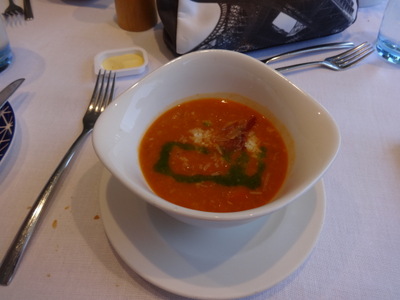
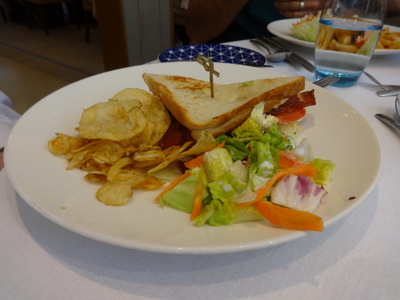 Lunch followed the usual pattern for all shipboard lunches: the menu offered starters (both "regional" and "regular"), main courses, desserts, and "always available" items (at lunch, basically chef's salad, hot dogs, and hamburgers). In addition a large appetizer and salad buffet was laid out that also included a pasta station. When you sat down, a waiter took orders for drinks and anything you wanted off the menu, then you were free to visit the buffet. You could, e.g., order just a main course and dessert, then get your salad off the buffet; or order nothing and make your whole meal off the buffet; or order three courses and supplement them off the buffet; or any combination you liked. If you wanted two main courses, not a problem.
Lunch followed the usual pattern for all shipboard lunches: the menu offered starters (both "regional" and "regular"), main courses, desserts, and "always available" items (at lunch, basically chef's salad, hot dogs, and hamburgers). In addition a large appetizer and salad buffet was laid out that also included a pasta station. When you sat down, a waiter took orders for drinks and anything you wanted off the menu, then you were free to visit the buffet. You could, e.g., order just a main course and dessert, then get your salad off the buffet; or order nothing and make your whole meal off the buffet; or order three courses and supplement them off the buffet; or any combination you liked. If you wanted two main courses, not a problem.
I started with the regular starter—white bean soup with crispy pancetta and basil pesto. You can see the pancetta and the basil, but the "white bean" woup was pretty tomatoey. Good though.
For the main course, David (inexplicably, to my mind) chose the BLT.

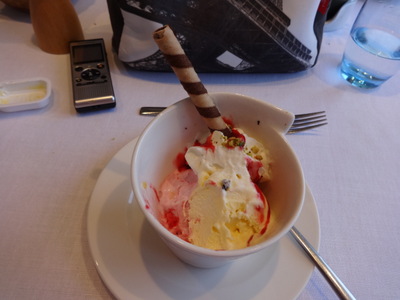 I went for the other main course choice, roast lamb and gravy with potatoes, individually peeled baby broad beans, and fresh thyme. The "regional specialties" were "antipasta with pesto," salmon crostini, and penne all' arrabbiata (the day's pasta-station choice, which I agree is a regional specialty but not of the region we were in).
I went for the other main course choice, roast lamb and gravy with potatoes, individually peeled baby broad beans, and fresh thyme. The "regional specialties" were "antipasta with pesto," salmon crostini, and penne all' arrabbiata (the day's pasta-station choice, which I agree is a regional specialty but not of the region we were in).
For dessert, I had the peach melba (vanilla ice cream, sliced peaches, and raspberry sauce).
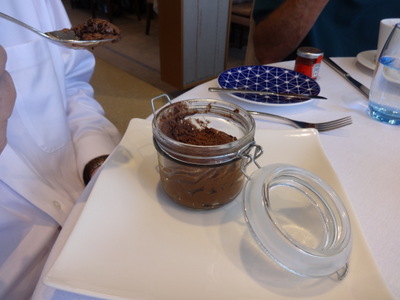
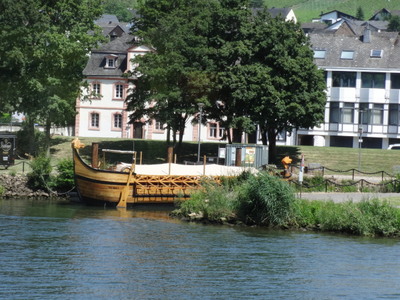 Because all the dessert choices were fruit (the other two were plum crumble and fresh fruit cup), David went with the "always-available" chocolate mousse.
Because all the dessert choices were fruit (the other two were plum crumble and fresh fruit cup), David went with the "always-available" chocolate mousse.
We were cruising along as we ate, and I got this shot of a wooden boat docked next to a little ticket booth. Note the carved dragon's head on the end nearest the shore. The scenery was an endless panorama steep vineyards and quaint little towns.
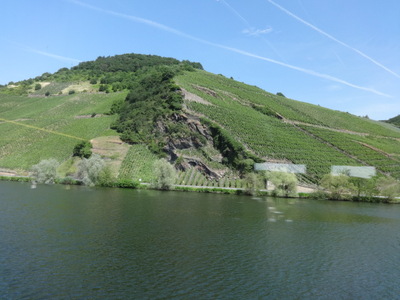
 Here, at the left, is one photo I got during the afternoon scenic cruising. It shows the typical planting of Reisling up and down the slopes, but note also in the center, just a few yards above the edge of the river, a little arched opening in th erock. It doesn't seem very deep, although the grower may use it for storage, but the arch serves mainly to support a small terrace on which a few more vines could be planted. Above it on the hillside, you can see the face of a triangular retaining wall holding up another terrace.
Here, at the left, is one photo I got during the afternoon scenic cruising. It shows the typical planting of Reisling up and down the slopes, but note also in the center, just a few yards above the edge of the river, a little arched opening in th erock. It doesn't seem very deep, although the grower may use it for storage, but the arch serves mainly to support a small terrace on which a few more vines could be planted. Above it on the hillside, you can see the face of a triangular retaining wall holding up another terrace.
At 5:30 p.m., we docked in Bernkastel, across the river from much smaller Kues, now part of the same municipality. While some of our fellow passengers enjoyed a casual get-together in the lounge with drinks and live music, we set off on our optional wine-tasting excursion. No need for buses, as we were moored right at the town, which was small (under 8000 population).
The wine tasting started with a visit to this little wine cellar, which used to be the main aging facility back when the winery was much smaller. Now the barrels are filled only with water, to keep the staves from drying out, shrinking, and cracking; the main winery is now much larger and is outside the town. A couple of candles burned in holders on top of barrels, and the proprietor told us that back when the barrels were filled with wine, candles were always kept burning throughout the room, as an early warning system for CO2 accumulation and oxygen depletion (aging wine soaks up oxygen and replaces it with CO2.
Each barrel weights about 1400 kg and holds 1000 liters of wine. Under the conditions, the oak barrels can last 150 years, but they lose their flavor after only 2 to 3 years, so old barrels are good for storage but useless for flavoring wine.
The romans arrived about 300 AD and brought wine to the region (the soldiers were paid in wine). Many different wines are made from the same (Riesling) grape juice, depending on fermentation temperature, timing of yeast addition and removal, etc. The slaty soil retains heat and drain well. Riesling likes cool weather and good drainage. The soil is really only about 10% soil, the rest slate. 90% of of local wines are white, and 60% of that is Riesling. I dutifully tasted all four wines we were offered, but they did nothing to alter my reaction to wine. To quote Bertie Wooster's friend Gussie Fink-Nottle, "you drink that muck for pleasure?!"
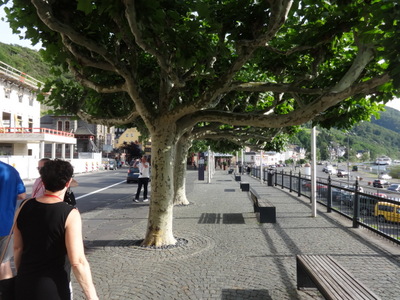
 After the wine tasting, our local guide took us for a walk through the town. At the left here is a portion of the river-front walk. Actually, a smaller road and a parking lot separate it from the actual river, where two cruise ships were tied up (one of them ours). I liked the handsome allée of sycamores down the sidewalk. Those trees, genus Platanus, are called "platanes" in French, "plane trees" in England, and sycamores in the US. In France, "sycamore" is the common name of their sole maple species; I don't know what the Brits call that.
After the wine tasting, our local guide took us for a walk through the town. At the left here is a portion of the river-front walk. Actually, a smaller road and a parking lot separate it from the actual river, where two cruise ships were tied up (one of them ours). I liked the handsome allée of sycamores down the sidewalk. Those trees, genus Platanus, are called "platanes" in French, "plane trees" in England, and sycamores in the US. In France, "sycamore" is the common name of their sole maple species; I don't know what the Brits call that.
At the right, he explains to us an inscription chalked (or perhaps painted) over a doorway. It begins with 20 and ends with 19, in between are the initials C-M-B. The initials stand for the names of the three wise men (Caspar, Melchior, Balthazar), but they also stand for a Latin phrase meaning "May Christ bless this house." Apparently, on the anniversary of the arrival of the three wise men at Bethlehem, groups of costumed young people go from door to door collecting money for the church. If the householder contributes, he gets the inscription over his door. This place apparently contributed in 2019 (the 20 and the 19 flanking the initials). If not, the previous year's inscription is left unchanged, so if you see one ending in 17, you know that no contribution has been made in the last two years. You see these inscriptions on many houses, in many towns.

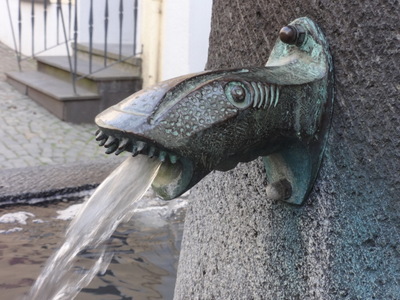 Here's the fountain in the middle of town—"Bernkastel" literally means "bear castle." Around the bottom are several water spouts, one of which I show at the right. I asked the guide what kind of creature it was supposed to be and was told it was almost certainly something imaginary. Nope, not buyin' it. I think it's a river lamprey.
Here's the fountain in the middle of town—"Bernkastel" literally means "bear castle." Around the bottom are several water spouts, one of which I show at the right. I asked the guide what kind of creature it was supposed to be and was told it was almost certainly something imaginary. Nope, not buyin' it. I think it's a river lamprey.
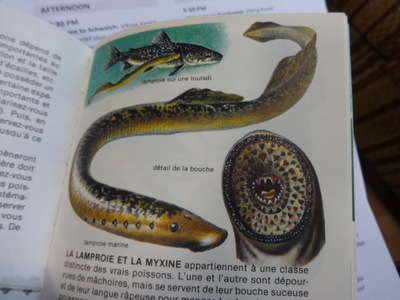
 Compare this photo of a page from my French-language fish guide. Lampreys are extremely primitive fish that are external parasites of many species of sport fish. Apparently our guide was neither a fisherman nor a resident of Bordeaux (where they eat lampreys in a red-wine sauce).
Compare this photo of a page from my French-language fish guide. Lampreys are extremely primitive fish that are external parasites of many species of sport fish. Apparently our guide was neither a fisherman nor a resident of Bordeaux (where they eat lampreys in a red-wine sauce).
Nearby was this handsome olive tree (in bloom) forming the focus of an eight-sided park bench.

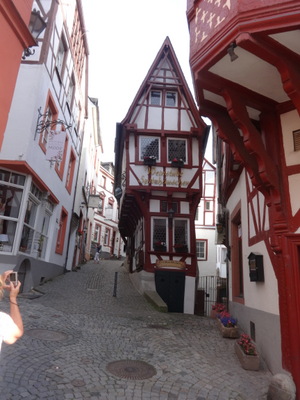 Here are some handsome old half-timbered houses.
Here are some handsome old half-timbered houses.
And right around the corner from them (to the left of the photo) is the most famous house in Bernkastel-Kues, the "Pointed House." Its owner, an elegant lady of perhaps 40, happened to be walking down the street toward us, and thanks to the Quietvox system, the guide was able to point her out to us discreetly. She had passed before a I took the photo. The place is now a wine bar.
Among the other interesting things we saw were many quaint narrow streets with grapevines over the doorways, an iron fence with beautiful purple passionflower growing on it, a rock shop with a huge amethyst-filled geode affixed to its outside wall (high over our heads), and several walls decorated with dated high-water marks from previous floods. As recently as 2003, the town had three feet of water in the streets.
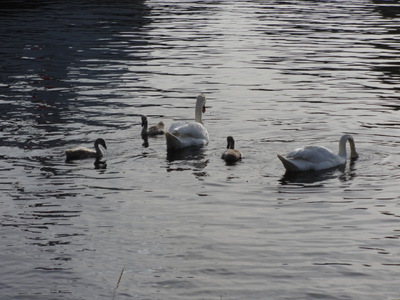
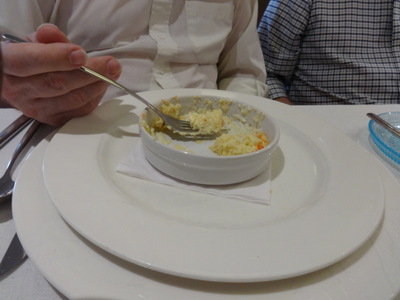 After the tour, we walked back to the ship in time for dinner, where this family of swans was paddling around our mooring.
After the tour, we walked back to the ship in time for dinner, where this family of swans was paddling around our mooring.
David started with French goat cheese soufflé, which he pronounced pretty good.
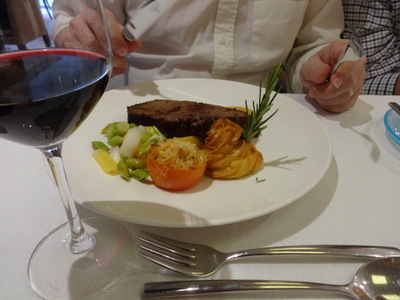
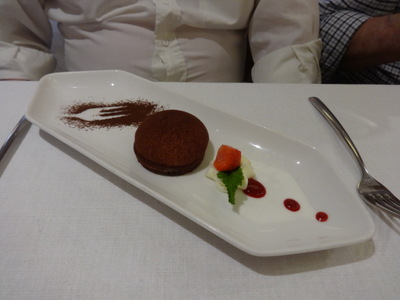 He then had the faux-filet (New York strip) steak with Roquefort sauce, Provençal tomato, and duchess potatoes.
He then had the faux-filet (New York strip) steak with Roquefort sauce, Provençal tomato, and duchess potatoes.
The dessert was billed as balsamic pear tart with chocolate sauce and wheat crumble, but as you can see, it looked like a little chocolate molten lava cake.
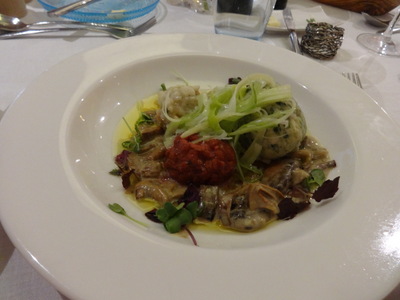
 I skipped the starter and ordered two main courses, because I wanted to try the "regional specialty" dumpling trio (spinach, cheese, and plain bread) as well as the "regular" grilled seabass with lemon, caper, and parsley sauce.
I skipped the starter and ordered two main courses, because I wanted to try the "regional specialty" dumpling trio (spinach, cheese, and plain bread) as well as the "regular" grilled seabass with lemon, caper, and parsley sauce.
The dumplings were okay. The came on a bed of quite good mushroom ragout and were topped with shreds of leek. I assume the one with large green flecks was the spinach-flavored one, but I couldn't tell whether the white one was cheese or plain. As for the bright red one, it was presumably plain or cheese, but with beet juice added. I wouldn't order any of them again—pretty heavy and gummy.
The seabass (our old friend Dicentrarchus labrax) was excellent. I think I just had ice cream for dessert.
Nobody ordered the vegetarian main course (quinoa, fava beans, avocado, and frisée lettuce) or the "regional-specialty" starter (Reisling, spinach, and cheese soup). The regional specialty dessert was a vanilla parfait with crunchy nougat and raspberry sauce called "heisse liebe," which I'm pretty sure means "hot love."
After dinner, a local singer and pianist entertained in the lounge (mostly English-language standards), followed Ivan at the piano for dancing. At any point in the cruise, when the boat is moored, passengers are free to go ashore and wander around by themselves (so long as they take their little landing cards with them). Some elect to skip onboard meals and go out to find local restaurants instead.
But the Viking Daily always includes a warning—be back on board by this time (on this date, it was 9:45 p.m.) because we're going to sail away again. Everybody made it back, and as scheduled, we set sail again at 10:00 p.m. for Cochem.
Previous entry
List of Entries
Next entry

 The day's tour started with a bus ride up the hill to a high point overlooking the city and the river. Out the windshield of the bus, we got our first sight or Riesling vines. To our surprise, nobody here practices "contour plowing"; the rows of vines invariably run straight up and down the hills, on slopes that are sometimes as steep as 60°! We later learned that this is the orientation that maximizes exposure of the vine leaves to the sun.
The day's tour started with a bus ride up the hill to a high point overlooking the city and the river. Out the windshield of the bus, we got our first sight or Riesling vines. To our surprise, nobody here practices "contour plowing"; the rows of vines invariably run straight up and down the hills, on slopes that are sometimes as steep as 60°! We later learned that this is the orientation that maximizes exposure of the vine leaves to the sun.
 The view was panoramic. At the left here, the guide indicaes the middle of town. Front and center among the buildings, just beyond the band of trees is a large white structure, and sticking off the right-hand side of it is a pinkish structure with four tall openings in it. That pinkish structure is a Roman ruin. Near the top of the hill on the other side of the river (which itself is hidden by buildings and trees) near the right-hand edge of the picture is a vertical structure (very small in the photo and also pinkish), Mary's column. Also along the ridge top, difficult to see because they are white against pale blue, is a line of modern windmills.
The view was panoramic. At the left here, the guide indicaes the middle of town. Front and center among the buildings, just beyond the band of trees is a large white structure, and sticking off the right-hand side of it is a pinkish structure with four tall openings in it. That pinkish structure is a Roman ruin. Near the top of the hill on the other side of the river (which itself is hidden by buildings and trees) near the right-hand edge of the picture is a vertical structure (very small in the photo and also pinkish), Mary's column. Also along the ridge top, difficult to see because they are white against pale blue, is a line of modern windmills.
 When I fired up the telephoto, I got much better shots of the Roman ruin and Mary's column.
When I fired up the telephoto, I got much better shots of the Roman ruin and Mary's column.

 At the left here, also by telephoto, is St. Peter's cathedral. Just in front of it you can see part of the Liebfrauen Basilika, which we got to go inside later.
At the left here, also by telephoto, is St. Peter's cathedral. Just in front of it you can see part of the Liebfrauen Basilika, which we got to go inside later.
 Back down on the flat, our local guide continued with a walking tour of the city center. At the left here is a foot left over from Roman times, part of an oversize statue of Constantine the Great.
Back down on the flat, our local guide continued with a walking tour of the city center. At the left here is a foot left over from Roman times, part of an oversize statue of Constantine the Great.
 At the left here is the Prince Elector's palace. It used to have another long pink wing to the left of what you see here, and when it but was demolished, the most economical way anyone could come up with to restore the symmetry of the view (the other wing couldn't also be demolished because it contained a stairway that was considered a treasure even at the tim) was to plant the line of trees at the right, to hide the long pink wing that extends in that direction. At the right is a closer view of the decorations above the central doorway, which features quite a lot of unclothed women for an archbishop's palace. Flower beds surrounding the lawn are replanted twice a season. The first planting features tulips and other spring bulbs. We were there shortly after the second planting, and I saw dahlias, impatiens, begonias, marigolds, argeratum, nasturiums, dusty miller, and a dozen other things I couldn't name. There were lilacs in the nearby park, but they weren't in bloom. Gardeners on their hands and knees were using skinny, two-tined weeding rakes weed between the bedding plants.
At the left here is the Prince Elector's palace. It used to have another long pink wing to the left of what you see here, and when it but was demolished, the most economical way anyone could come up with to restore the symmetry of the view (the other wing couldn't also be demolished because it contained a stairway that was considered a treasure even at the tim) was to plant the line of trees at the right, to hide the long pink wing that extends in that direction. At the right is a closer view of the decorations above the central doorway, which features quite a lot of unclothed women for an archbishop's palace. Flower beds surrounding the lawn are replanted twice a season. The first planting features tulips and other spring bulbs. We were there shortly after the second planting, and I saw dahlias, impatiens, begonias, marigolds, argeratum, nasturiums, dusty miller, and a dozen other things I couldn't name. There were lilacs in the nearby park, but they weren't in bloom. Gardeners on their hands and knees were using skinny, two-tined weeding rakes weed between the bedding plants.
 The basilica is now a protestant church. Only about 10% of the city's population is protestant, and most of them work at the university. Because they're from all over, and were brought up in different protestant denominations, the church is of the Prussia United denomination, which is apparently the one most acceptable to everyone.
The basilica is now a protestant church. Only about 10% of the city's population is protestant, and most of them work at the university. Because they're from all over, and were brought up in different protestant denominations, the church is of the Prussia United denomination, which is apparently the one most acceptable to everyone. 
 Here, at the left, is a more general view of the interior of the basilica (together with the back of David's head). The scaffolding supports a platform for people working on the ceiling.
Here, at the left, is a more general view of the interior of the basilica (together with the back of David's head). The scaffolding supports a platform for people working on the ceiling.
 Our walking tour continued to the cathedral, St. Peter's. Here at the left is the gate to the cathedral precinct (what the Brits would call the "close"). During the time when the archbishops ruled the area, the cathedral precinct was an entirely different district of law. It made a big difference whether you committee a crime inside or outside it, and if you reached it and got inside before they caught you outside, you were safe. Arresting you would have been a sin, which was worse than a crime. The gate was called the "turning around point," because it was where it was safe for a running miscreant to stop and look behind him.
Our walking tour continued to the cathedral, St. Peter's. Here at the left is the gate to the cathedral precinct (what the Brits would call the "close"). During the time when the archbishops ruled the area, the cathedral precinct was an entirely different district of law. It made a big difference whether you committee a crime inside or outside it, and if you reached it and got inside before they caught you outside, you were safe. Arresting you would have been a sin, which was worse than a crime. The gate was called the "turning around point," because it was where it was safe for a running miscreant to stop and look behind him.
 The inside of the basilica is sumptuously decorated. The guide showed us the exact spot (marked by a gold star set in the floor) on which to stand to have a full view of all the paintings on the 12 interior columns (the twelve apostles, I think). At the left here is a view into the apse of the church, and at the right a better view of its painted ceiling.
The inside of the basilica is sumptuously decorated. The guide showed us the exact spot (marked by a gold star set in the floor) on which to stand to have a full view of all the paintings on the 12 interior columns (the twelve apostles, I think). At the left here is a view into the apse of the church, and at the right a better view of its painted ceiling.
 Here are a couple exterior shots of St. Peter's. In Roman times, it was the only church in the world larger than St. Peter's in Rome. It had four basilicas. Its baptismal font was about 20 feet square and knee deep (and is now marked by a stone outline in the pavement outside). Wading in up to your knees and pouring a spoonful of the water over your head counted as a "full-immersion" baptism.
Here are a couple exterior shots of St. Peter's. In Roman times, it was the only church in the world larger than St. Peter's in Rome. It had four basilicas. Its baptismal font was about 20 feet square and knee deep (and is now marked by a stone outline in the pavement outside). Wading in up to your knees and pouring a spoonful of the water over your head counted as a "full-immersion" baptism.
 At the left here is the market square. In its center (not visible in this shot) is the market cross, the oldest (and the only) Celtic market cross in Germany; it stands on a Roman column. Out of the shot to the left is the oldest pharmacy in Germany (mentioned in 13th-century; at one time, that whole side of the square was pharmacies). As the guide pointed out, because Trier is the oldest city in Germany, everything there is the oldest of its kind. We also walked along the oldest "New Street" in Germany.
At the left here is the market square. In its center (not visible in this shot) is the market cross, the oldest (and the only) Celtic market cross in Germany; it stands on a Roman column. Out of the shot to the left is the oldest pharmacy in Germany (mentioned in 13th-century; at one time, that whole side of the square was pharmacies). As the guide pointed out, because Trier is the oldest city in Germany, everything there is the oldest of its kind. We also walked along the oldest "New Street" in Germany.
 Lunch followed the usual pattern for all shipboard lunches: the menu offered starters (both "regional" and "regular"), main courses, desserts, and "always available" items (at lunch, basically chef's salad, hot dogs, and hamburgers). In addition a large appetizer and salad buffet was laid out that also included a pasta station. When you sat down, a waiter took orders for drinks and anything you wanted off the menu, then you were free to visit the buffet. You could, e.g., order just a main course and dessert, then get your salad off the buffet; or order nothing and make your whole meal off the buffet; or order three courses and supplement them off the buffet; or any combination you liked. If you wanted two main courses, not a problem.
Lunch followed the usual pattern for all shipboard lunches: the menu offered starters (both "regional" and "regular"), main courses, desserts, and "always available" items (at lunch, basically chef's salad, hot dogs, and hamburgers). In addition a large appetizer and salad buffet was laid out that also included a pasta station. When you sat down, a waiter took orders for drinks and anything you wanted off the menu, then you were free to visit the buffet. You could, e.g., order just a main course and dessert, then get your salad off the buffet; or order nothing and make your whole meal off the buffet; or order three courses and supplement them off the buffet; or any combination you liked. If you wanted two main courses, not a problem.
 I went for the other main course choice, roast lamb and gravy with potatoes, individually peeled baby broad beans, and fresh thyme. The "regional specialties" were "antipasta with pesto," salmon crostini, and penne all' arrabbiata (the day's pasta-station choice, which I agree is a regional specialty but not of the region we were in).
I went for the other main course choice, roast lamb and gravy with potatoes, individually peeled baby broad beans, and fresh thyme. The "regional specialties" were "antipasta with pesto," salmon crostini, and penne all' arrabbiata (the day's pasta-station choice, which I agree is a regional specialty but not of the region we were in).
 Because all the dessert choices were fruit (the other two were plum crumble and fresh fruit cup), David went with the "always-available" chocolate mousse.
Because all the dessert choices were fruit (the other two were plum crumble and fresh fruit cup), David went with the "always-available" chocolate mousse.
 Here, at the left, is one photo I got during the afternoon scenic cruising. It shows the typical planting of Reisling up and down the slopes, but note also in the center, just a few yards above the edge of the river, a little arched opening in th erock. It doesn't seem very deep, although the grower may use it for storage, but the arch serves mainly to support a small terrace on which a few more vines could be planted. Above it on the hillside, you can see the face of a triangular retaining wall holding up another terrace.
Here, at the left, is one photo I got during the afternoon scenic cruising. It shows the typical planting of Reisling up and down the slopes, but note also in the center, just a few yards above the edge of the river, a little arched opening in th erock. It doesn't seem very deep, although the grower may use it for storage, but the arch serves mainly to support a small terrace on which a few more vines could be planted. Above it on the hillside, you can see the face of a triangular retaining wall holding up another terrace.
 After the wine tasting, our local guide took us for a walk through the town. At the left here is a portion of the river-front walk. Actually, a smaller road and a parking lot separate it from the actual river, where two cruise ships were tied up (one of them ours). I liked the handsome allée of sycamores down the sidewalk. Those trees, genus Platanus, are called "platanes" in French, "plane trees" in England, and sycamores in the US. In France, "sycamore" is the common name of their sole maple species; I don't know what the Brits call that.
After the wine tasting, our local guide took us for a walk through the town. At the left here is a portion of the river-front walk. Actually, a smaller road and a parking lot separate it from the actual river, where two cruise ships were tied up (one of them ours). I liked the handsome allée of sycamores down the sidewalk. Those trees, genus Platanus, are called "platanes" in French, "plane trees" in England, and sycamores in the US. In France, "sycamore" is the common name of their sole maple species; I don't know what the Brits call that. Here's the fountain in the middle of town—"Bernkastel" literally means "bear castle." Around the bottom are several water spouts, one of which I show at the right. I asked the guide what kind of creature it was supposed to be and was told it was almost certainly something imaginary. Nope, not buyin' it. I think it's a river lamprey.
Here's the fountain in the middle of town—"Bernkastel" literally means "bear castle." Around the bottom are several water spouts, one of which I show at the right. I asked the guide what kind of creature it was supposed to be and was told it was almost certainly something imaginary. Nope, not buyin' it. I think it's a river lamprey.
 Compare this photo of a page from my French-language fish guide. Lampreys are extremely primitive fish that are external parasites of many species of sport fish. Apparently our guide was neither a fisherman nor a resident of Bordeaux (where they eat lampreys in a red-wine sauce).
Compare this photo of a page from my French-language fish guide. Lampreys are extremely primitive fish that are external parasites of many species of sport fish. Apparently our guide was neither a fisherman nor a resident of Bordeaux (where they eat lampreys in a red-wine sauce).
 Here are some handsome old half-timbered houses.
Here are some handsome old half-timbered houses.
 After the tour, we walked back to the ship in time for dinner, where this family of swans was paddling around our mooring.
After the tour, we walked back to the ship in time for dinner, where this family of swans was paddling around our mooring.
 He then had the faux-filet (New York strip) steak with Roquefort sauce, Provençal tomato, and duchess potatoes.
He then had the faux-filet (New York strip) steak with Roquefort sauce, Provençal tomato, and duchess potatoes.
 I skipped the starter and ordered two main courses, because I wanted to try the "regional specialty" dumpling trio (spinach, cheese, and plain bread) as well as the "regular" grilled seabass with lemon, caper, and parsley sauce.
I skipped the starter and ordered two main courses, because I wanted to try the "regional specialty" dumpling trio (spinach, cheese, and plain bread) as well as the "regular" grilled seabass with lemon, caper, and parsley sauce.